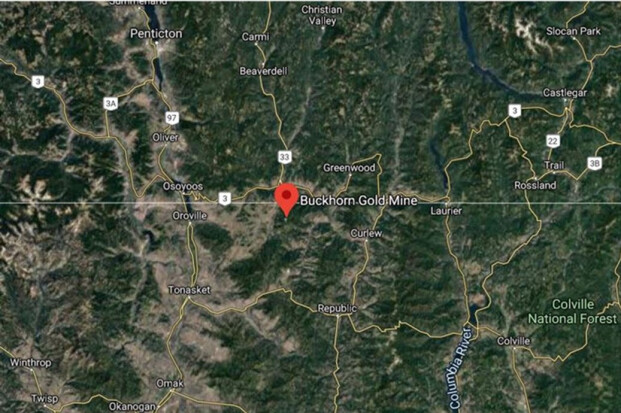
“Everyone has a duty to protect our waters, including multi-million dollar corporation. The mining operation knew about the potential pollution before they started construction. But when the pollution showed up and the state required them to fulfill their promise to contain it, they chose a protracted legal battle instead — and lost, repeatedly.”
Attorney General Bob Ferguson
Buckhorn Gold Mine releases pollutants into previously untouched streams, according to AG Ferguson
SPOKANE — Attorney General Bob Ferguson today filed a federal lawsuit against two gold mining companies for violating the Clean Water Act and discharging illegal levels of pollutants into creeks flowing into the Kettle River in Okanogan County. The companies could face millions of dollars in penalties for Clean Water Act violations.
Ferguson filed today’s federal lawsuit in the U.S. District Court for the Eastern District of Washington in Spokane against Crown Resources and Kinross Gold, the owners of the Buckhorn Mountain gold mine. Ferguson asserts the companies repeatedly violated the Clean Water Act and the Washington Water Pollution Control Act over the course of six years, doing little to comply with their water quality permit and contain the pollution from the mine. The mine releases contaminants including arsenic and lead into nearby waterways. These contaminants are harmful to people, water ecosystems and fish species like trout.
For years, Crown and Kinross have been aware they were violating the law. Rather than taking action to stop this pollution, the mine chose instead to pursue six years of unsuccessful litigation in state court over its water quality permit with the state, according to the AG’s office.
“Everyone has a duty to protect our waters, including multi-million dollar corporations,” Ferguson said. “The mining operation knew about the potential pollution before they started construction. But when the pollution showed up and the state required them to fulfill their promise to contain it, they chose a protracted legal battle instead — and lost, repeatedly.”
Crown Resources and its parent company, Kinross Gold, own Buckhorn Mountain gold mine, a 50-acre underground mine in Okanogan County located in the highlands about 30 miles east of Oroville, near Chesaw and about four miles from the Canadian border. From 2008 to 2017, the companies extracted approximately $1.3 billion in gold from the mine’s miles of underground tunnels. A majority of these tunnels lie below the water table. Ore extraction stopped in 2017, but contaminants continue to be released from the mine.
Since the mine’s construction, it has released pollutants to waters in and around the mine — including both groundwater and nearby streams, which flow into the Kettle River. These pollutants include aluminum, ammonia, arsenic, lead and nitrates. Prior to the mine’s construction, these streams were largely untouched and showed little evidence of contamination from human activity.
This pollution is ongoing.
Crown and Kinross knew about the potential for pollution before the mine was constructed. The state conducted an environmental review of Crown’s mine proposal prior to the mine’s construction. The review identified potential impacts to nearby waters, noting that the mine would create the risk of “acid mine drainage” — highly acidic liquid, often containing toxic metals, that drains off a mine’s newly excavated rock and ore. The review also noted that the use of explosives like dynamite at the mine could release pollutants into nearby waters.
Legal violations
Entities that release pollutants into Washington waterways, including companies like Crown, are required by law to obtain a water quality permit from the state. The water quality permit for the Buckhorn mine requires Crown to capture and treat water impacted by the mine’s operations, including stormwater, wastewater and contaminated groundwater.
Because the mine releases contaminants into largely untouched mountain waters, the state is required by law to issue a permit to the mine with stringent contaminant limits to prevent degradation of these relatively pristine waters. If the mine’s pollution continues at current levels, it could create serious adverse impacts to the nearby water ecosystem, including fish species in the Kettle River.
Since 2014, the mine has not properly captured contaminated water, allowing contaminants to consistently escape the mine at levels well above those allowed by the water quality permit. This violates federal Clean Water Act and the Washington Water Pollution Control Act, the state’s version of the Clean Water Act.
For example, in Crown’s November 2019 discharge monitoring reports, Crown reported chloride levels at a groundwater seep monitoring point that were eight times the permissible monthly average level allowed in its permit. That same month saw average monthly average exceedances at other ground and surface monitoring stations for sulfate, arsenic, ammonia, and nitrates.
Crown fought permit in court and failed to contain pollution
Instead of taking action to comply with the new permit and reduce its pollution, Crown spent six years unsuccessfully fighting the permit in court. In 2015, Crown appealed the permit to the Washington Pollution Control Hearings Board, which upheld the permit. Crown appealed that decision to Ferry County Superior Court, then the Washington Court of Appeals — both of which denied Crown’s appeal and ruled that the permit still stands.
Throughout Crown’s repeated failed appeals, the permit remained in effect. The company did not make an adequate effort to comply with the permit, nor did it ask for or receive a stay from the court that would have put the permit on hold during the legal proceedings.
Ferguson’s lawsuit asks the court to require Crown to meet the terms of their permit, remediating damage from years of pollution. The lawsuit asks the court to award monetary penalties and attorney’s fees. The maximum penalty under the Clean Water Act is $54,800 per violation, per day, for up to five years. The Attorney General’s Office estimates that the potential Clean Water Act penalty could be in the millions of dollars.
Assistant Attorneys General Kelly Wood and Elizabeth Harris with the Environmental Protection Division, and Assistant Attorney General Chris Reitz with the Ecology Division, are handling this case on behalf of the Attorney General’s Office.
The lawsuit was filed with consultation from the Washington State Department of Ecology. Okanogan Highlands Alliance, a citizen’s group that has long monitored water quality issues at the Buckhorn mine, filed a similar lawsuit in April.
Protecting the environment is one of Ferguson’s top priorities. In 2016, he created the Environmental Protection Division, first known as the Counsel for Environmental Protection Unit, to protect our environment and the safety and health of all Washingtonians.
Kinross Responds
In response, Gina Myers, Director of Reclamation at Kinross’ Republic office, said the company plans to vigorously defend what she describes as a “strong environmental stewardship” of the mine against the litigation.
“It is a fact that the company’s adherence to the highest environmental standards during operation and closure, which includes operation of our advanced reverse osmosis water treatment plant, has resulted in discharge water at or below drinking water standards,” said Myers.
She said It is unfortunate that the Washington AG’s Office has decided to pursue this litigation while the company has been working diligently and cooperatively with the State’s Department of Ecology on implementing the approved closure plan for the mine and a renewal of its discharge permit that is protective of the environment.
“The current discharge permit is unreasonable, based on flawed assumptions and did not properly consider the natural background levels nor previously permitted mine activities. The current permit sets unattainable limits that, in many cases, are below natural background levels,” she said.
Myers claims permit also set an arbitrary and artificial “capture zone” boundary which, among other things, does not account for facilities that were designed and installed to manage water that fall outside this “capture zone.”
“As we have always done, we will continue our activities in an environmentally responsible manner, including continued reclamation and closure activities at the now-closed Buckhorn Mine,” she said.





